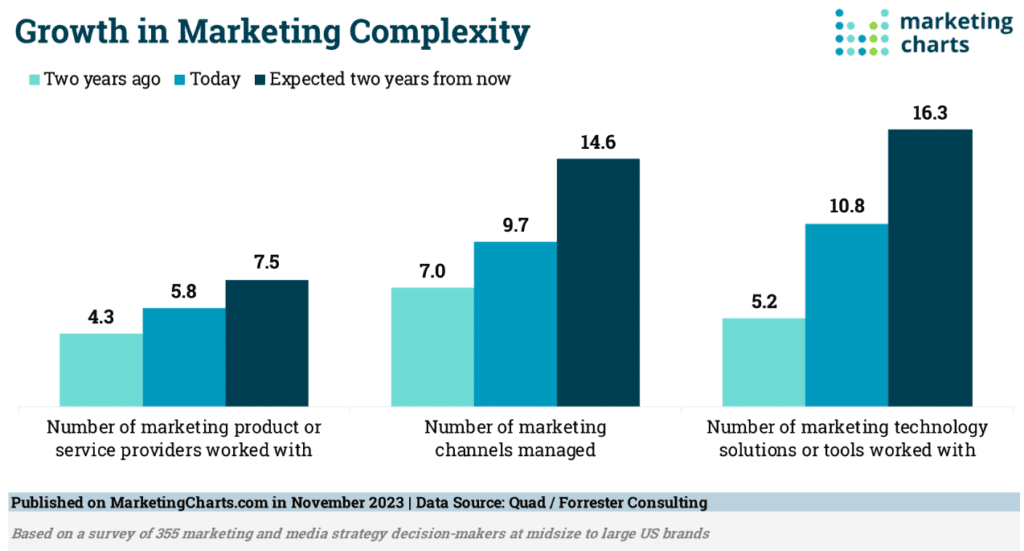What is Chat Engine Optimization?



Learn how to stay visible online in the age of chat bots by leveraging search, answer, and chat engine optimization for discovery, ...
Building a marketing program isn’t for the faint of heart. Communications strategies have gotten orders of magnitude more complex over the past decade. And, strategies that once required a knowledgeable resource or two, now take an entire team of strategic, creative, and technical experts. Reaching new customers while staying within your limitations is possible. But, you’ll need to pull an elephant sized-rabbit out of a teacup-sized hat to make it work.
This gap between expectations and resources has led to a Frankenstien-esque group of marketing strategies and teams to implement them. They tend to include marketing “unicorns”, interns, and agency partnerships strung together with duct tape and glue. While they may check all of the requisite boxes to be called a team, they develop entropy and burn out quickly. In this post, we’ll explore strategies for building a high-functioning marketing team without breaking the bank.
In a frictionless world, our products and services would fly “off the shelf” forever, in a state of perpetual growth. Unfortunately for sellers, the path to purchase is filled with roadblocks. Brand trust, decision fatigue, and price anxiety are just a few of the reasons consumers give for abandoning the buying process. And, oftentimes, the buyer journey ends before customers have even gotten to know you.
Effective marketing counteracts these objections by answering the most common questions before buyers even know they have them. What is this product’s real value in my life? How is it different from similar products? Why should I believe that it can produce the results it says it can? Our job, as marketers, is to cut a swath through these objections by completing the purchase, establishing a relationship, and growing advocacy.
There are, of course, many ways to accomplish that. From brute-force campaigns that leave audiences annoyed but aware, to humorous ones that disarm buyers, but score lower in overall recall. In an increasingly attention-constrained world, however, the one thing an effective strategy absolutely has to do is reach critical mass. That means going beyond the channel-driven marketing of yesteryear and starting to think in outcomes.
None of this is to say that a strategically placed single-channel campaign can’t make an impact; they can and do. It’s that we live in a world so saturated with messages that new customer relationships require us to transcend the channel-focused strategies of the past. Organizations that want to keep up need to think in terms of brand experiences. Or, how the totality of messaging delivered across all touchpoints drives advocacy, rather than not sales.
So, why do you need a marketing team? Standing out in today’s business ecosystem takes more than a single-channel messaging strategy. It takes a deeply integrated team of subject matter experts working together in real-time, alongside other rev-ops specialists – from customer service to sales. If you’re not a large mid-market or enterprise brand, getting there means thinking outside the box.
Your first marketing hire will be a leader. If not a full-blown manager, director, or officer, then someone who has an innate curiosity about the factors that influence your audience’s decision-making processes. One of the most common traps when hiring for the role is the tendency to look for a marketing “unicorn” or “ninja”. As the name implies, however, the strategy is akin to a conductor who also plays every instrument in the orchestra. In other words, ineffective.
The best leaders in this new communications ecosystem aren’t multi-faceted strategic, creative, and technical prodigies. They’re project managers with deep emotional intelligence, an analytical mind, and conceptual thinking. They tend toward a high degree of organizational thinking with the ability to weave many different threads into a single compelling brand experience. One that drives the type of word of mouth that makes every marketing dollar you spend more valuable.


In fact, you’d probably be surprised at how little understanding a marketing leader needs in a specific channel or vertical to be successful. The right candidate isn’t building pay-per-click campaigns or writing social media posts. They’re helping people that do specialize in these areas be more efficient, reach their target audience, and convert more often. They’re working to align your brand with a target audience by delivering the right messaging to the right people at the right time.
If you don’t have the resources to bring on a full-time marketing leader quite yet, don’t worry; you still have plenty of options in the interim. Platforms like UpWork or Fiverr will allow you to build a team in stages without committing to an ongoing expense. First, find a qualified marketing consultant that can customize a strategy to your unique resources and goals. Next, find independent contractors that can perform the services.
Just remember that when you’re faced with limited resources, as many of them as possible should be dedicated to kickstarting word of mouth. Yes, you’ll be overseeing your own program for awhile. But, the strategy is often enough to bridge the resources gap and get your marketing plan moving in the right direction. Other alternatives include an SMB marketing agency or even a fractional (or part-time) CMO. Both usually have some amount of strategy and project management resources built into their offering.
The quickest way to burn money in marketing is by not spending enough of it to begin with. A great leader with lots of strategy and limited resources will underperform a mediocre leader with limited strategy and lots of resources every time. That means if you’re not ready to support a marketing leader with a team, you may want to think twice about hiring one in the first place. Stay with us, though; the next couple of steps will help you get there more quickly.
When getting started, a good budgeting rule of thumb is to set aside at least, double your marketing leader’s salary. That won’t build you the enterprise-level marketing machine of your dreams. But, with a deeper understanding of how marketing teams scale, you can begin to bridge the gap and grow. Start by looking at the most typical types of marketing teams:
Channel teams are characterized by a multi-role executive working with one or more autonomous subject matter experts. Their deliverables tend to be fairly narrow in scope and designed to gain traction within niche audiences. Without a strong central marketing leader, they tend to produce a relatively low degree of storytelling, but are also flexible, efficient, and relatively low-commitment. That makes them a popular way for very small organizations to create a toehold before taking the next steps.
Hub-and-spoke teams are usually characterized by an in-house marketing leader working with multiple independent contractor or agency partners. The strategy is popular in the startup, nonprofit, and B2B spaces, where it allows leaders to build a cohesive strategy without going overcommitting. The lack of cross-channel integration, however, often creates a dynamic where partners compete for your marketing dollar, rather than working together to amplify it.
Fractional marketing agency teams are usually characterized by an in-house marketing leader working with a single integrated marketing support team. In this managed services relationship, the agency embeds directly into the client’s existing organizational workflow instead of working as an outside partner. The strategy allows leaders to build seamless omnichannel stories reminiscent of a dedicated marketing team without the costs and commitment. As the organization grows, early gains are often pumped back into acquiring additional inhouse resources
Dedicated marketing teams are usually characterized by a combined in-house marketing leader and team. This more traditional strategy allows organizations deploying it to create omnichannel brand experiences at scale, only calling on external resources for niche expertise. However, it also requires lots of resources to build, manage, and support, so tends to be unique to mid-market and enterprise organizations.
The most important thing they don’t teach in business school is that the purpose of marketing isn’t to sell things. It’s to act as the tip of the spear in creating an audience so passionate about your product and services that they sell things for you. In fact, it’s one of the most powerful ways to boost the value of your marketing dollar. That may seem self-evident. But, you may also be surprised at how common it is for leaders to fall back on the practice of strong-arming new business at quadrupal the price.
As your marketing team grows, remember that communications is only one endpoint in a revenue operations ecosystem that includes sales, product, and support. And, you can draw a straight line between the collaboration between them and the time, cost, and speed of scaling your marketing team. Aligning each department around a common audience, voice, and business outcome will be one of your most important jobs of your marketing team. It will also have the biggest impact on its growth.
Growing any organization in this business environment can feel exciting, impossible, and maddening, all at the same time. Getting your message to potential customers practically requires a full-time marketing staff, but those same teams are out of reach for most. Catalyst can help. We’re an integrated marketing agency purpose-built to help growing organizations scale smarter. If you’d like a hand in reaching your goals, let’s talk.



